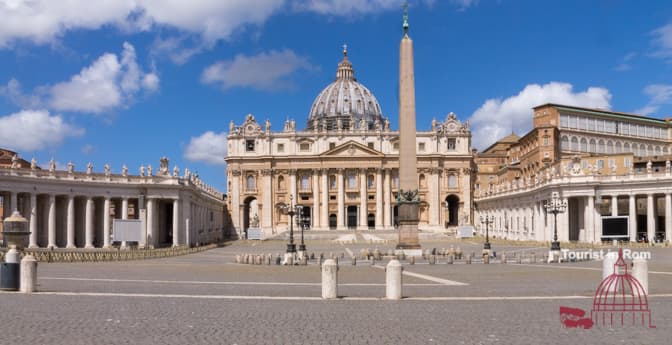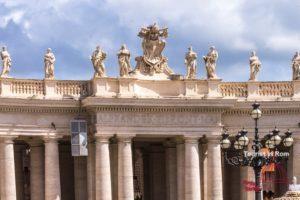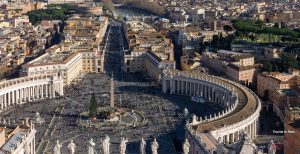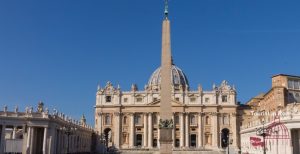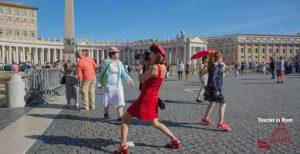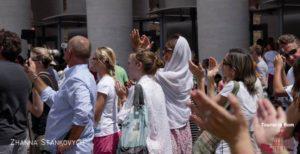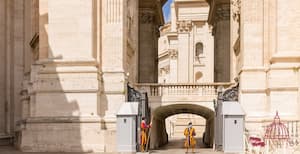St. Peter’s Square in Vatican City is an architectural masterpiece. Completed in 1667, the square is one of the greatest scenographies of Baroque Rome.
Practical tips
St. Peter’s Square opening hours: 6.30 a.m. – 10 p.m., during the Christmas period until midnight
Security check: St. Peter’s Square is usually accessible without a security check. There is only a security check for the Wednesday morning general audiences, the Sunday noon papal prayer, and the masses in the square. Glass bottles, cans, knives, screwdrivers and scissors are prohibited. Beverages in plastic bottles are also prohibited during Masses and public audiences.
Vatican Post: Who wouldn’t enjoy receiving a letter or postcard from the Vatican? The impressive stamps are a popular collector’s item. A post office is located on the right side between the Colonnade and the Leonine Wall, over which the Passetto leads to the Castel Sant’Angelo. Another mobile post office is usually on the left side of the square. Stamps are also available at the souvenir shop to the left of St. Peter’s.
How to get there:
| Line | Stop | Distance |
| Tram 19, Bus 32, 81 | Risorgimento/S. Pietro – Crescenzio | 550 m |
| Bus 34, 46, 62, 64, 98, 881, 916 | Cavalleggeri/S. Pietro | 600 m |
| Bus 23, 34, 40, 46, 62, 64, 98, 115, 280, 870, 881, 916 | Lungotevere Sassia/ Santo Spirito | 800 m |
| Metro A | Ottaviano | 1.000 m |
| Train | San Pietro | 1.200 m |
Restrooms: There are restrooms behind the right colonnade, in the Visitor Center to the right of St. Peter’s Basilica, and at the souvenir shop on the left side of the square.
History of St. Peter’s Square
Emperor Constantine, who made Christianity the state religion and had the first basilicas built, began construction of the first St. Peter’s Basilica between 319 and 326 on the burial ground of the Vatican Hill, on the site where the tomb of St. Peter is believed to be. In order to build there, he had the hill with the tombs leveled.
The square in front of the Basilica remained empty and it was not until the 5th century that a fountain was built. No other buildings from this period are known.
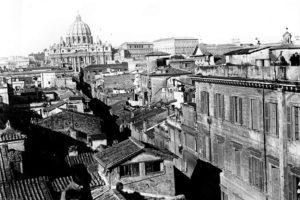
spina-di-borgo-1936/
In the 15th century, Pope Pius II ordered the construction of a marble staircase and a blessing chapel. On the occasion of the Jubilee of 1500, Pope Alexander VI had the Via Alessandrina built, which led from Ponte Sant’Angelo to the Apostolic Palace. The Spina di Borgo was built with shops and lodgings and blocked the view of St. Peter’s Basilica. Between the Basilica and the Borgo was a rectangular field with a slope of about 10 meters.
In 1505 the construction of the new St. Peter’s Basilica began and after an eventful history it was consecrated in 1626. History of St. Peter’s Basilica
After the completion of the Basilica, attention turned to the design of the forecourt. The Fabbrica di San Pietro hoped to generate large revenues by renting or selling apartments and shops overlooking the square. Bernini was commissioned to design a trapezoidal square with arcades and shops.
In 1657, however, Pope Alexander VII intervened and imposed Bernini’s alternative project of a free-standing portico. This masterpiece of Baroque architecture still shapes the image of St. Peter’s Square today.
The project by Gian Lorenzo Bernini
Gian Lorenzo Bernini, the brilliant Italian architect and sculptor, faced a great challenge when he was commissioned to design St. Peter’s Square. Not only did the square have to frame the majestic St. Peter’s Basilica, but it also had to solve several problems posed by the topography and existing buildings.
Challenges:

- Different orientations: The Borgo, the medieval quarter around St. Peter’s, was oriented toward Via Alessandrina and the Apostolic Palace, while the new St. Peter’s with the Obelisk formed a new axis.
- Proportions and height: The façade of St. Peter’s was too wide in relation to its height, and attempts to add towers had failed. The new cathedral was also 3.2 meters higher than the old basilica, resulting in an additional 3 meters of drop.
- The position of the obelisk: The obelisk is located at a lower point on the square and its position could not be changed.
Bernini’s solution:
- The oval shape: Bernini chose an oval shape for the piazza, which solved the topographical problems better than an angular square. Bernini justified the oval by stating that “St. Peter’s, as the mother church of all others, must have a portico that clearly demonstrates its motherly welcome with open arms, to Catholics to confirm them in the faith, to heretics to unite them in the Church, and to unbelievers to enlighten them to the true faith.”
- Colonnades: The two colonnades that frame the square add to the imposing setting. They also offered protection and peace to the pilgrims. Originally, a third colonnade was planned to close the square at the front, so that the Basilica would be visible only upon entering the square, surprising the pilgrims. However, this project was not realized for reasons of cost.
- The sun in the center: Bernini may also have been inspired by Kepler’s teachings. Publicly stating that the planets revolved around the sun would have gotten him into trouble with the Inquisition. However, the fact that the obelisk from Heliopolis stands in the center of the square and the two fountains appear to revolve around it like planets suggests a reference to Kepler’s heliocentric view of the world.
Facts and figures about St. Peter’s Square
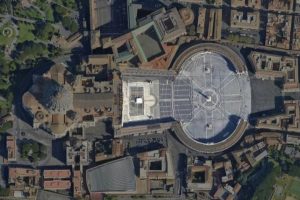
St. Peter’s Square is composed of two parts: the trapezoidal part that rises up to St. Peter’s Basilica, Piazza Retta, and the oval part framed by Bernini’s colonnades.
- Total area: about 47,600 sqm
- Piazza Retta (in front of St. Peter’s) 12,300 sqm
- Oval square: 35,300 sqm
- Maximum width: 240 m
- Maximum depth: 340 m
- Elliptical square: about 60,000 visitors (info from Vatican News for Easter Sunday ’24)
- Record: up to 300,000 pilgrims (including Piazza Pio XII and Via di Conciliazione)
- Age: about 4,000 years
- Origin: Heliopolis, Egypt
- Height: 25.31 m (with base and cross: 40 m)
- Weight: 330 tons (with base: 505 tons)
- Age of the fountain in front of the Basilica: since the 5th century
- Reconstruction: 1614 by Carlo Maderno
- Transfer of the fountain: 1667 by Gian Lorenzo Bernini
- Second fountain (“twin fountain”): built by Bernini on the south side
- Water supply: Aqua Paola aqueduct from Lake Bracciano
- Recycling system: installed under Pope Paul VI
- Completed: 1613 by Carlo Maderno
- Width: 118.6 m
- Height (without statues): 48 m
- Height of the statues: 5.7 m
St. Peter’s Square: details and symbolism
St. Peter’s Square is one of the most important sites of Christianity. The imposing square, with its obelisk, fountains and colonnades against the backdrop of St. Peter’s Basilica, radiates a unique atmosphere of history, faith and art, with its signs and mysteries.
The obelisk
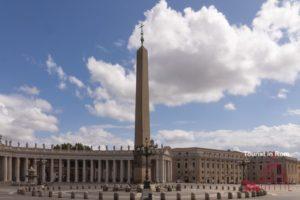
The Obelisk in St. Peter’s Square is more than just an ancient monument. It symbolizes the victory of faith over paganism and the steadfastness of St. Peter.
At 40 meters, it is the second tallest obelisk in Rome and is unique in that it has no hieroglyphics.
The obelisk stood for 18 centuries in Heliopolis, Egypt, before it was brought to Rome on a ship filled with lentils by order of the Emperor Caligula in 37 A.D. and erected in his racecourse on the Vatican Hill.
According to tradition, the Apostle Peter was executed here under Emperor Nero and buried next to the Circus. St. Peter’s Basilica was built on the site of the supposed tomb, and the obelisk stood not far from it in front of the sacristy.
Pope Sixtus V wanted to place the obelisk as a central element in front of the basilica. Under the direction of the architect Carlo Fontana, it was moved to its present position in 1586 with the help of 907 men, 75 horses and 40 winches.
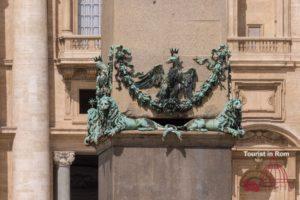
To transform the pagan obelisk into a Christian monument, it was decorated with inscriptions, a cross and the coat of arms of Pope Sixtus V (lion, three mountains, star). Later, the crowned eagle of Pope Innocent XIII was added.
Since Bernini could not move the obelisk, it was placed at the lowest point of St. Peter’s Square. From there, Bernini had the square raised again in the direction of Piazza Papa Pio XII, so that the dome over the facade of St. Peter’s remained visible.
Signs on the square

The compass rose: In 1821, a compass rose was set into the pavement around the obelisk. 16 panels show the points of the compass. The name of the wind blowing from each direction is given for each cardinal point, and the vivid images make it easy to imagine the effects of these winds.
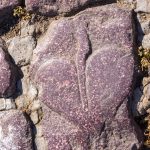
The heart of Nero: Among the cobblestones around the Libeccio wind is a stone with a heart or leaf on it. The Romans call it Il cuore di Nerone. There are many legends about this stone that tell of unhappy love. Whether it was Michelangelo, Bernini or a woman who lost her lover, we will probably never know!
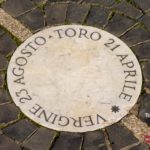
Signs of the Zodiac: The obelisk doubles as a sundial. For this purpose, plaques with the signs of the zodiac were set into the ground. The shadow of the obelisk at noon – 1 p.m. in summer – shows the current sign of the zodiac.

Angels Unawares: The work depicts 140 refugees, including an unknown angel, on a raft. You can see that they come from different times and different parts of the world. At the inauguration of the 6-meter-long bronze statue in 2019, on the World Day of Migrants and Refugees, Pope Francis reminded us that no one should be excluded from society. The name of the work refers to Hebrews 13,2: “Do not forget to show hospitality! For without knowing it, some have received angels into their homes in this way”.
Bernini’s Masterpiece: The Colonnades of St. Peter’s Square
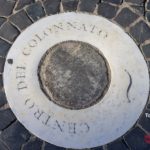
The colonnades are Bernini’s masterpiece. The columns of a semicircle are all oriented toward a center that is indicated by a mark “Centro del Colonnato” on the ground. If you stand on this mark, the columns are aligned so that the three columns at the back disappear behind the first column. The diameter of the columns increases towards the outside to maintain the proportions. The fact that Bernini was able to create these impressive effects despite the difficulties of the terrain, with its varying gradients, is proof of his particular skill.
The facade of St. Peter’s
The façade of St. Peter’s is the work of Carlo Maderno. He was also responsible for the construction of the nave and the portico, which were added to the circular church designed by Michelangelo. The facade had to be kept as low as possible so as not to cover Michelangelo’s dome. After its completion around 1612, it was decided to build two towers on the right and left. However, the towers could not be completed because the ground gave way and the construction stopped at the level of the façade.
In order to maintain the proportions, the columns are designed in a colossal order and extend over several floors. On the lower floor there are five passages to the portico with bronze grilles, on the upper floor there is the Hall of Blessings, the Aula delle Benedizioni, with five balconies. The central balcony is the Loggia delle Benedizioni, from which the Pope gives the Urbi et Orbi blessing. The newly elected Pope is also proclaimed here.
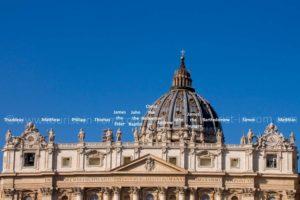
The facade is adorned with 5.7-meter-high statues of Jesus, John the Baptist and eleven apostles. St. Peter is missing because the Basilica is dedicated to him and his statue stands in St. Peter’s Square to the left of the Basilica.
The clocks
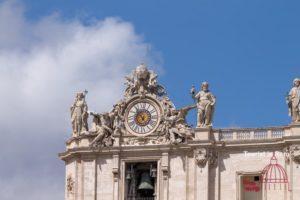
The architect and goldsmith Giuseppe Valadier completed the unfinished towers of the façade with two clocks. The clock faces are 4 meters in diameter. The left clock, called “Oltremontano”, shows the current time.
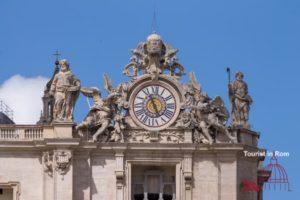
The clock on the right is a curiosity. It is called “Italico” and is supposed to show the Italic time.
The Italico clock shows the time half an hour after sunset, so it shows XII half an hour after sunset and XII again after 12 hours. The advantage of this method is that you can estimate the time until the next sunset. This was very important when there was no electric light.
If you now read the clock on the right and calculate with the sunset, you will notice that the clock does not show the correct time. We asked the Vatican and they told us that the clock was wrong so that the devil wouldn’t arrive in time for mass.
The Piazza Retta
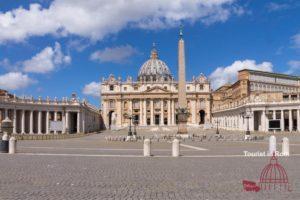
Piazza Retta is the part of St. Peter’s Square that rises in a trapezoid shape toward St. Peter’s Basilica. The rising trapezoid shape creates an optical illusion that makes the façade appear closer and larger. The visitor enters the Basilica on the right and leaves it on the left in Piazza Retta. In between is the elevated forecourt of the church, where papal masses and general audiences are held. A fan-shaped staircase with 16 steps in granite and travertine leads to the forecourt on 3 levels, which could also be used by horsemen and carriages.
Conclusion
St. Peter’s Square is one of the most important places in Christendom. The imposing square with its signs and mysteries and with its scenario of obelisk, fountains and colonnades against the backdrop of St. Peter’s Basilica, radiates a unique atmosphere of history, faith and art.
More about St. Peter’s
More about the Vatican
